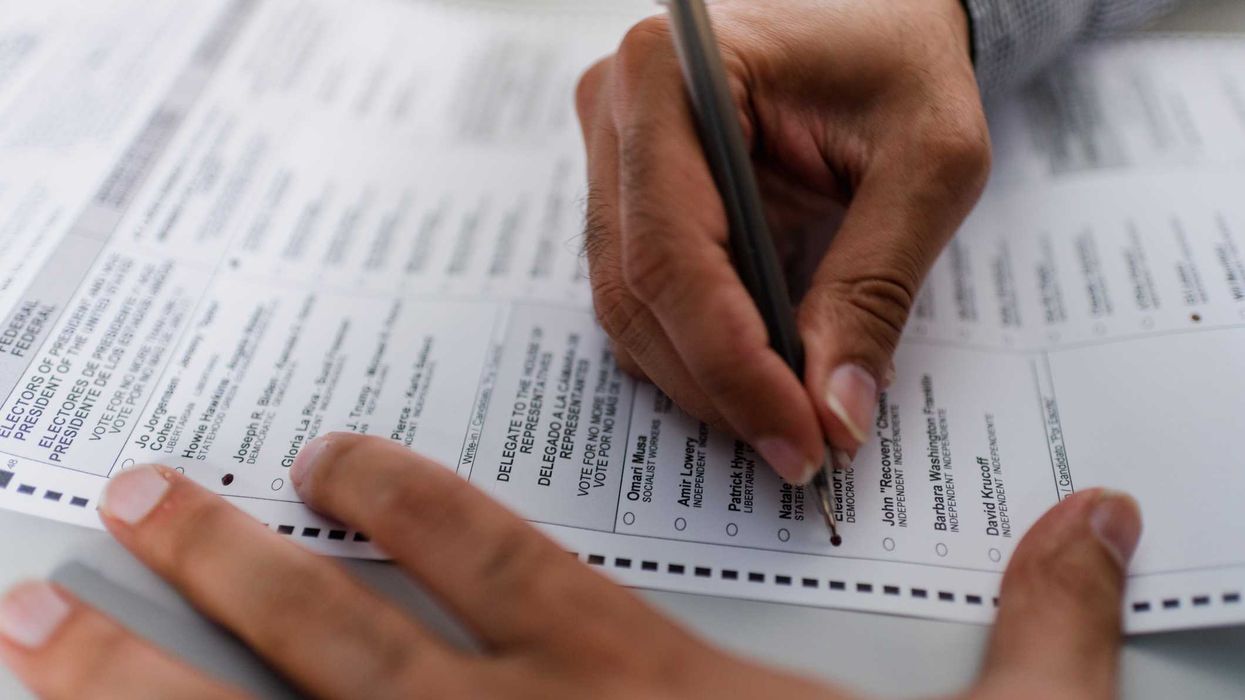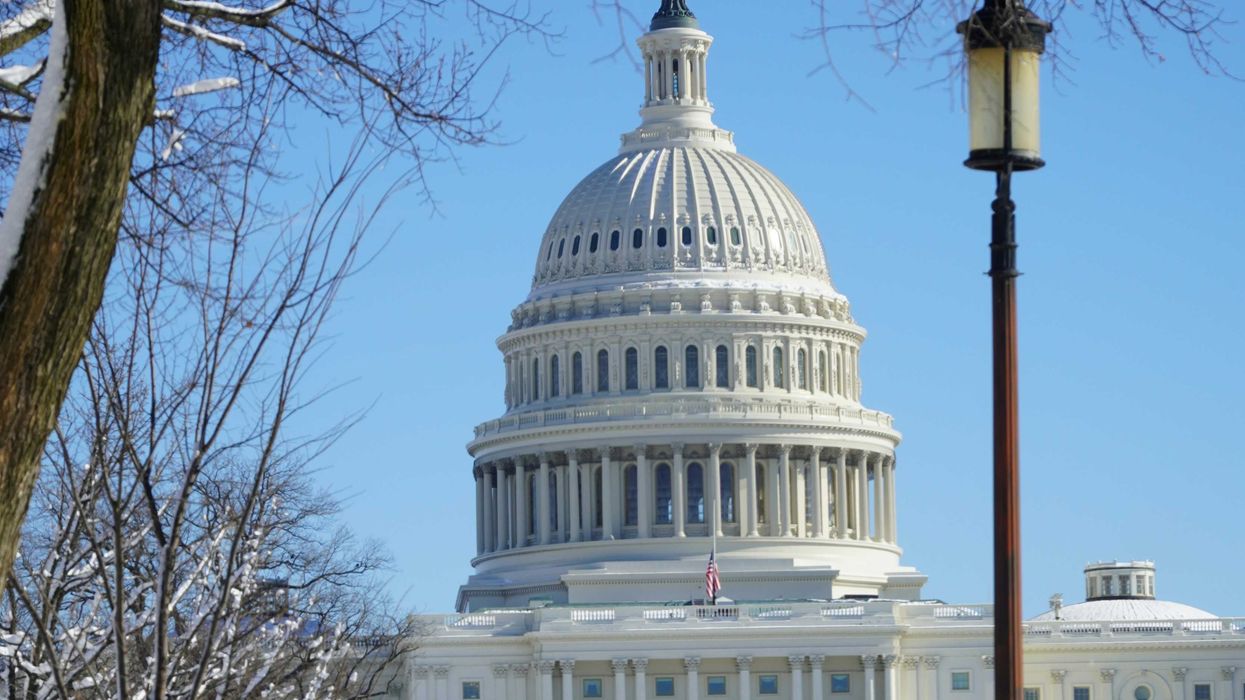Rosenfeld is the editor of Voting Booth, a project of the Independent Media Institute.
Since 2020’s presidential election, two rural counties in Michigan and Colorado that initially reported incorrect results have had outsized roles in spreading Donald Trump’s big lie that his second term was stolen by Democrats colluding with one of the country’s biggest computerized voting systems makers.
The mistaken 2020 election results occurred in two out of the more than 8,000 election jurisdictions across America. They were caused by county officials who did not properly set up the election system computers in Michigan and properly use them in Colorado. The errors, which notably were caught and corrected, received scant attention compared to the sensation they sparked in Trump circles where a cadre of self-proclaimed IT experts — and, later, some of the same officials who erred — asserted that the computers had been sabotaged.
What unfolded inside the election departments in Antrim County, Mich., and Mesa County, Colo., in pro-Trump circles that misunderstood but exploited the counties’ errors — and then fueled conspiratorial and likely illegal evidence-stealing gambits in other battleground states (such as Georgia) — is a cautionary tale before 2022’s state and federal elections.
The procedural lapses that led to initially wrong vote counts are among the findings in research by the Independent Media Institute’s Voting Booth project. It has co-authored a forthcoming guide about how vote-counting systems work. Duncan Buell, a lifelong computer scientist who has spent the past dozen years analyzing election systems, software, and data, and served as an election official, co-authored the guide. The lapses have recurred in every election cycle Buell has studied.
The revelation that complications surrounding using the newest voting system computers by local officials helped launch false but widely believed stolen-election narratives comes as scores of Trump-mimicking election deniers are running for state and federal office in 2022’s general election, and as Trump is still falsely claiming that he was re-elected in 2020.
Some candidates, such as Arizona GOP gubernatorial nominee Kari Lake, said on the eve of her August primary that the voting apparatus would be rigged unless she won—which she did. Lake’s claim drew scoffs, but most reporters and voters do not know how election computers are set up, and then detect and compile votes. Nor are they aware of basic operational mistakes that can mar this process.
The mistakes by a handful of local election administrators are rare but were confirmed and described in detail in several government-led investigations. They appear to be an unavoidable part of managing elections, especially as new technology is used in high-pressure contests.
Programming and operational errors that led to incorrect initial vote counts occurred in DeKalb County, Ga., in 2022’s primaries, in Northampton County, Pa., in 2019’s general election, and 2018 in South Carolina’s general election, which Buell witnessed as a member of the Richland County election board, where the state capital, Columbia, is located.
Comparable errors occurred using different voting systems, Buell noted, including computers from the country’s two biggest voting system firms, Election Systems and Software (ES&S) and Dominion Voting Systems.
“It is worth noting that all the errors observed in Antrim County, on Dominion equipment, have comparable errors that I have observed since 2010 in analyzing the ES&S data in South Carolina,” he said.
Election law attorneys and policy experts who are alarmed about the escalating threats to election officials by Trump factions since 2020 do not like to talk about the possibility that local officials may struggle with the newest election system computers. They have spent months defending election officials as above-the-fray experts that should be trusted, and pointedly say that it is a false equivalency to compare mistakes that get caught and corrected with intentional lies and stolen election conspiracies.
“I have no doubt in my mind that we would be in the same place had a water main in Fulton County not broken [in an Atlanta voting center], had Antrim County not happened,” said David Becker, founder of the Center for Election Innovation and Research, a non-partisan, non-profit that created a legal defense fund to assist threatened election officials. “These were excuses for the delegitimization of an election that was otherwise much more secure by any measure than anything we’ve ever had, thanks to paper ballots and audits.”
“Trump was using the rhetoric long before any specific instances happened in 2020,” said Ben Ginsburg, a longtime Republican election attorney, speaking at a September 6 briefing with Becker. “And David is exactly right. The system is designed to recognize that things aren’t going to be perfect. That’s why every state has recount proceedings, [vote] contest proceedings, and litigation. So, the notion that there will be mistakes is built into a process.”
Nonetheless, the fact remains that about two-thirds of the 74 million people who voted to re-elect Trump still believe the propaganda juggernaut that the election was illegitimate. In contrast, there are few efforts that explain and contextualize actual errors that occur. Typically, comments by election officials are terse and short-lived news items, acknowledging that mistakes were made and corrected.
Meanwhile, as the 2022 general election nears, many election officials are beefing up security protocols at county offices and operation centers, steps that may make their processes less transparent and invite more conspiratorial accusations.
Setting Up Voting Systems
This article is the start in a series that will explain what happened as actual mistakes occurred and how they become fodder for outsized false claims and disinformation about election results, officials and voting systems.
That some county election managers did not properly set up or use their system’s computers before 2020’s general election is not entirely surprising. Nor it is very surprising that Trump’s allies were poised to follow the former president’s cues and seek to exploit any error or procedural change to buoy their rhetoric.
What must be remembered are the claims of rigging and the concerns about changes to election processes occurred during a pandemic. In the middle of 2020’s presidential primaries, the COVID-19 pandemic arose. Some battleground states that did not postpone their primaries experienced a range of snafus, from poll workers who did not show up to last-minute consolidation of voting sites, creating confusion, congestion and delays for voters and election workers.
By summer, may states responded by encouraging the use of mailed-out ballots, which is a big procedural and logistical change for vetting voters and processing ballots. That abrupt transition came as many locales were using a new generation of election computers for the first time in a presidential election, which is always the highest turnout and most stressful general election to administer.
Introducing any new voting system or balloting option can be confusing for officials and voters. Election officials across the country knew their work would come under a microscope, and they took extra steps to ensure their results would be correct — emphasizing that most of the county would be voting on paper ballots for the first time in many presidential elections. But what is largely unappreciated about the newest generation of voting systems is they contained more individual computerized devices to process ballots than the prior generation of machines.
The new computers could number in the hundreds or thousands depending on the jurisdiction’s population. They include ballot-marking devices, scanners reading ballots, tabulators compiling precinct votes, and a central computer compiling all of the jurisdiction’s results. Each device must be programmed and synced with other computers at polling places and county operation centers.
Getting the correct ballot to voters and configuring the computers that cast or count votes is not simple or trivial — not when jurisdictions have 100s of different ballots. (Ballots vary as local races are added.) Nor are programming mistakes a “minor clerical error [that] turned into a major conspiracy theory,” as an August 26 report by the New York Times characterized Antrim County’s issues. Clerical tasks involve typos, not configuring, syncing, and verifying hundreds of ballot styles, thumb drives, and computers spanning voting sites and county headquarters.
In Antrim County, Mich., election workers did not check if all of the computers had been properly programmed and synced after some ballots were redesigned at the last minute. As a result, ballot scanners and tabulators did not have the correct list of candidates and wrongly assigned votes. The initial returns incorrectly reported that Joe Biden had won the conservative northern Michigan county.
In Mesa County, Colo., the back-office election manager did not know how to use a computer that completed the processing batches of 1,000 ballots to compile countywide results. As political party observers stood by, she double-counted more than 20,000 ballots. The scene was captured by overhead video cameras. She later made the same mistake in April 2021’s municipal election.
These mistakes were caught and corrected. Their details were documented by government investigations that issued several key reports. In Michigan, the first report ( March 2021) was prepared by one of the country’s leading voting system analysts for Secretary of State Jocelyn Benson, a Democrat. The second report was by the state senate’s Republican-led Michigan Senate Oversight Committee ( June 2021). In Colorado, Mesa County prosecutors issued a report ( May 2022) that described the operational errors and also refuted accusations by pro-Trump IT specialists that claimed the computer system had secretly stolen votes.
What was somewhat surprising after the 2020 election was the emergence of a cadre of publicity-seeking, self-proclaimed, pro-Trump IT specialists who started claiming that the election was stolen at the same time the Trump campaign lost more than 60 state and federal court lawsuits for lack of evidence.
The self-proclaimed election IT experts had virtually no prior experience with analyzing election system computers. Nor were they apparently aware of other post-Election Day safeguards that find and fix vote count errors. Nonetheless, they asserted that they found unexplained signs of fake votes that they attributed to secretive programming by the equipment manufacturer. Their accusations were among the many efforts by Trump and his allies to cast doubt on the election’s outcome before and after the January 6 insurrection at the U.S. Capitol.
But what was unexpected was that some of the county officials tasked with setting up and using these computers—including those who erred—would, months later, blame the mistakes on their computers, or publicly say their election system had been hijacked or were vulnerable to such hacking. In the spring of 2021, these officials began actively colluding with Trump’s conspiracy-minded IT squad.
Viral Lies, Slow Accountability
Of course, other partisan Republicans wanted Trump to win and helped set the stage for putting forth false stolen election claims.
Antrim County’s initial miscount went viral in pro-Trump circles. In early December 2020, a state judge, a former Michigan House Republican minority leader, ordered local election officials to allow outside investigators to analyze the county’s voting system’s computers. A firm hired by Trump’s lawyer, Sidney Powell, copied the system’s hard drives, software and data. (The copies, which the court said were not to be shared, were slowly and selectively leaked. They were widely distributed at an August 2021 forum led by Trump ally Mike Lindell.)
In mid-December 2020, a pro-Trump IT firm, Allied Security Operations Group (ASOG), issued its “forensic audit” report on Antrim County’s computers, which were made by Dominion Voting Systems (whose system was also used in Georgia and Arizona). Its summary said, “We conclude that the Dominion Voting System is intentionally and purposefully designed with inherent errors to create systematic fraud and influence election results. The system intentionally generated an enormously high number of ballot errors.”
Matthew DePerno, the Michigan Republican Party’s 2022 nominee for state attorney general, helped produce the ASOG report. (In August 2022, Michigan Attorney General, Dana Nessel, a Democrat seeking re-election, appointed a special prosecutor to investigate the illegal breach of the voting system. The appointment sought to avoid conflict-of-interest accusations.)
In response to ASOG’s report, Secretary of State Jocelyn Benson, a Democrat, commissioned one of the nation’s foremost election technologists, the University of Michigan’s J. Alex Halderman, to analyze what happened. His March 2021 report said ASOG’s review “contains an extraordinary number of false, inaccurate, or unsubstantiated statements and conclusions,” including repeatedly misreading computer logs that record every operation—from ballot paper jams to votes.
Halderman also described how Antrim election officials had failed to properly set up the system, which, in turn, led computers to assign accurately detected votes on paper ballots to the wrong line—and wrong candidate—in the county’s final results database. “The EMS [election management system] ignored most votes intended for [Joe] Biden, reported all votes intended for Trump as votes for Biden, and reported all votes intended for [Libertarian Jo] Jorgensen as votes for Trump,” his report said. “This pattern lets us almost exactly reproduce the erroneous initial results.”
But Trump’s allies, including his data gurus, ignored Halderman’s report and the Michigan Senate Oversight Committee’s report, issued by Republicans that June. Instead, they seized upon a strategy that they took to other states. Their mindset was to create chaos and doubt, so they went looking for fodder for their claims.
One day after the January 6 insurrection, the Atlanta-based technology firm that Powell hired to copy Antrim County’s voting system went to rural Coffee County, Georgia. There, a pro-Trump election official allowed the systems’ hard drives, software, and data to be copied. The official claimed in an online video that the system could be rigged, which also went viral in Trump circles.
In April 2021, Tina Peters, the Mesa County Clerk, shared unauthorized copies of her county’s election system with Trump’s IT allies. Even though Peters’ back-office election manager mistakenly double-counted votes, which was found and fixed, Peters went on to promote pro-Trump conspiracy theories and seek the GOP nomination for Colorado secretary of state in 2022’s primaries. (A day after she lost the primary, Peters was charged with 10 crimes tied to the data breach.)
Some of the IT specialists involved in these efforts then turned up in Arizona in its state-senate-sponsored post-2020 review led by Cyber Ninjas, a Florida-based IT firm. Its CEO, Doug Logan, contributed to ASOG’s report on Antrim County and was among the IT “experts” who went to Coffee County. In Arizona, he repeatedly raised doubts about the presidential election in the state’s most populous county. In September 2021, Logan announced that Biden won, but his team did not provide evidence showing that his IT squad had accurately recounted votes.
The Trump activists spent months claiming the presidential election was stolen. Many became fixtures—along with their false narrative—on pro-Trump media after the election and remain so today. In contrast, the responses by state and county authorities that initially defended their voting systems, and subsequently investigated and rebutted the accusations, drew less coverage.
Notably, the governmental responses cited and explained the procedural errors by county election managers before and after 2020’s Election Day—errors that were exploited and contributed to a disinformation juggernaut. These investigations also laid the groundwork for prosecuting rogue election officials, and possibly their partisan collaborators, for the illegal data breaches.
Mesa County’ Peters, for example, now faces 10 misdemeanor and felony charges. Georgia Secretary of State Brad Raffensperger, a Republican who Trump lobbied to “find votes” in an infamous telephone call that was recorded, has authorized a “ computer trespass investigation ” by state police in Coffee County. Michigan is investigating Antrim County’s unauthorized election data breaches.
But behind the stolen election allegations, which continue in Trump circles, and slower-moving criminal accountability, is a troubling trend that recurs in every election cycle. In a handful of counties, local election managers do not properly set up or operate their computers, giving election-deniers a propaganda vehicle.
These mistakes may be the exceptions, not the rule, across America’s 8,000-plus election jurisdictions. However, they are not “minor clerical errors,” as The Times characterized. They are errors at the start, and at the heart, of counting votes.
This article was produced by Voting Booth, a project of the Independent Media Institute.



















